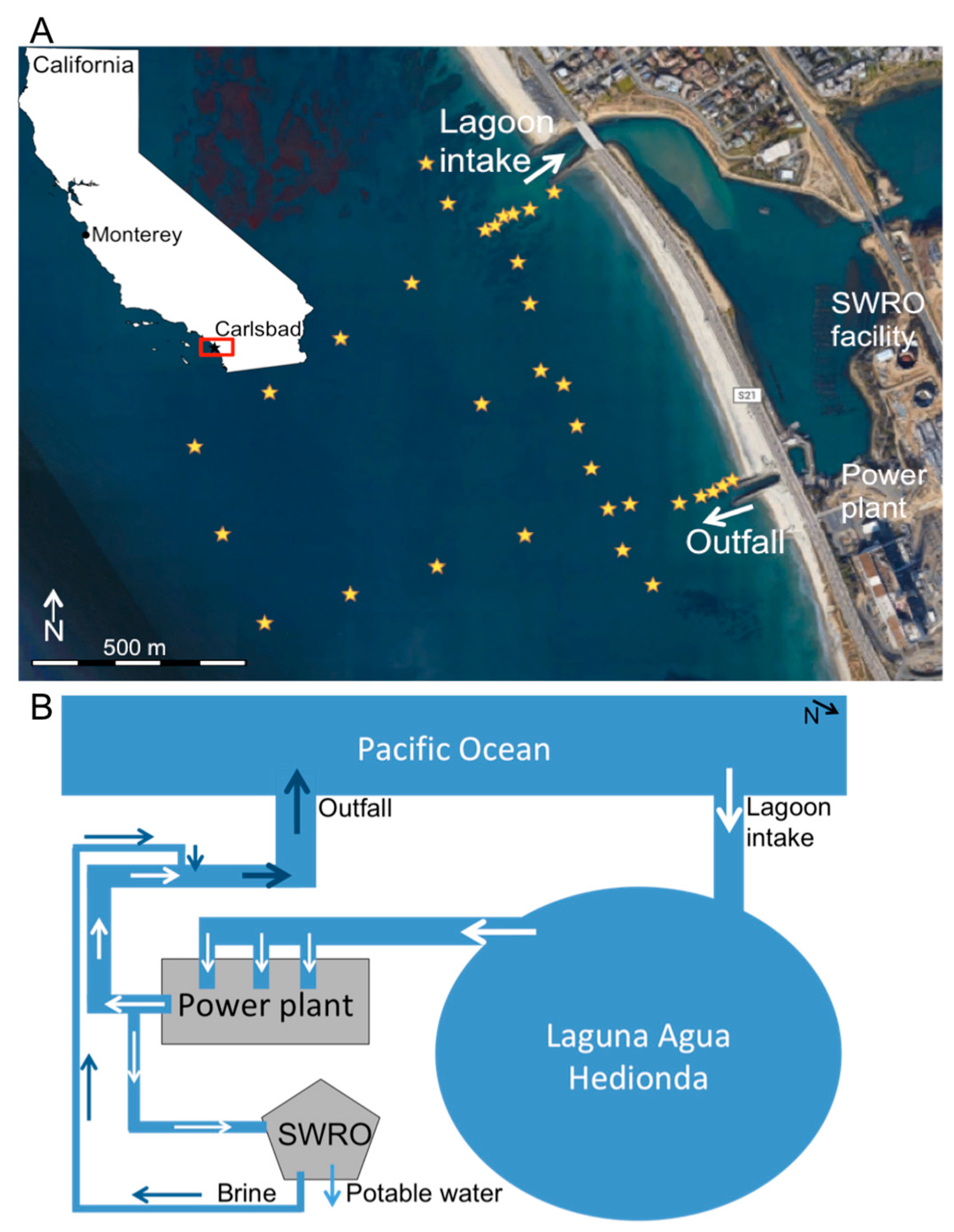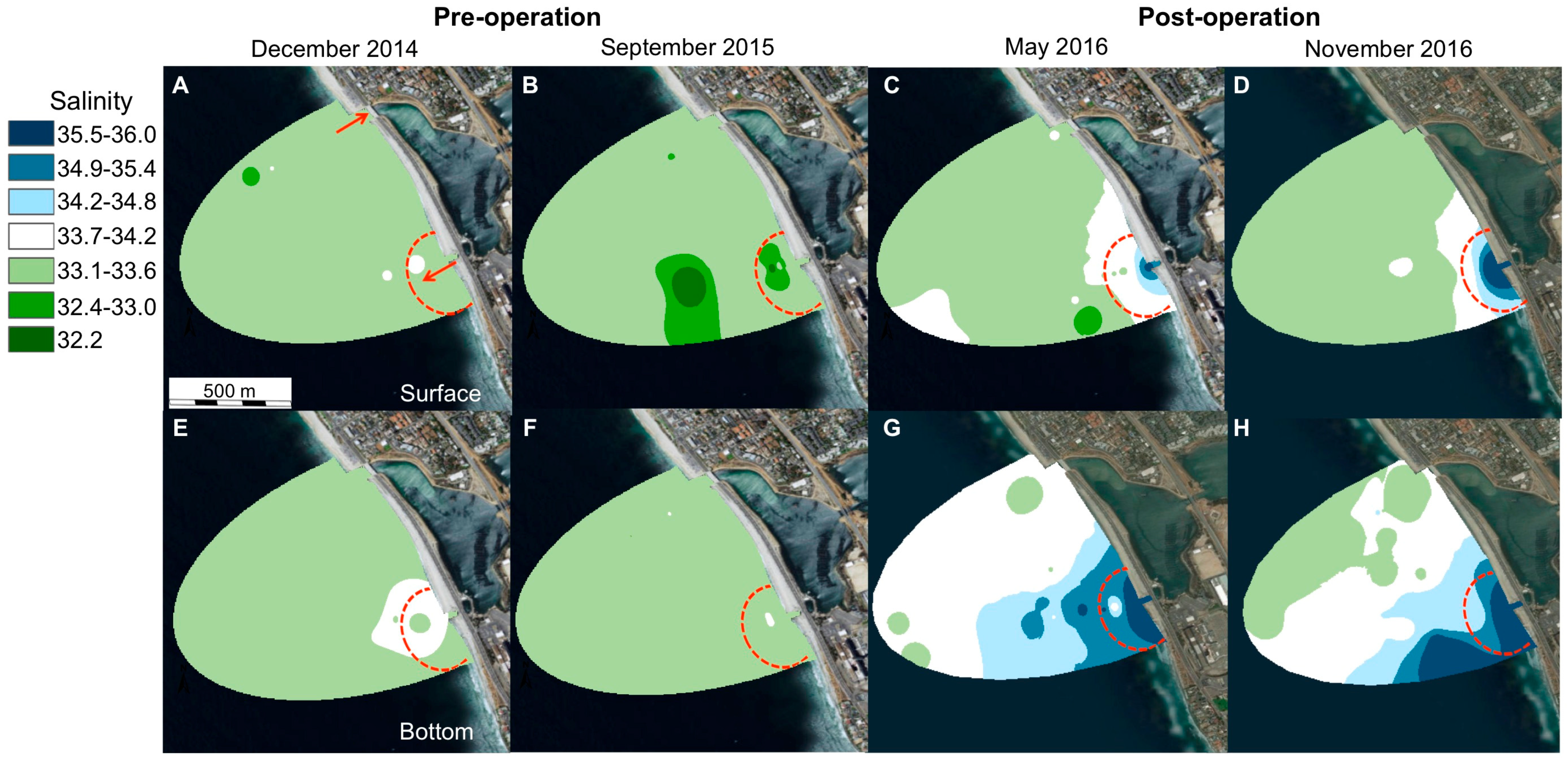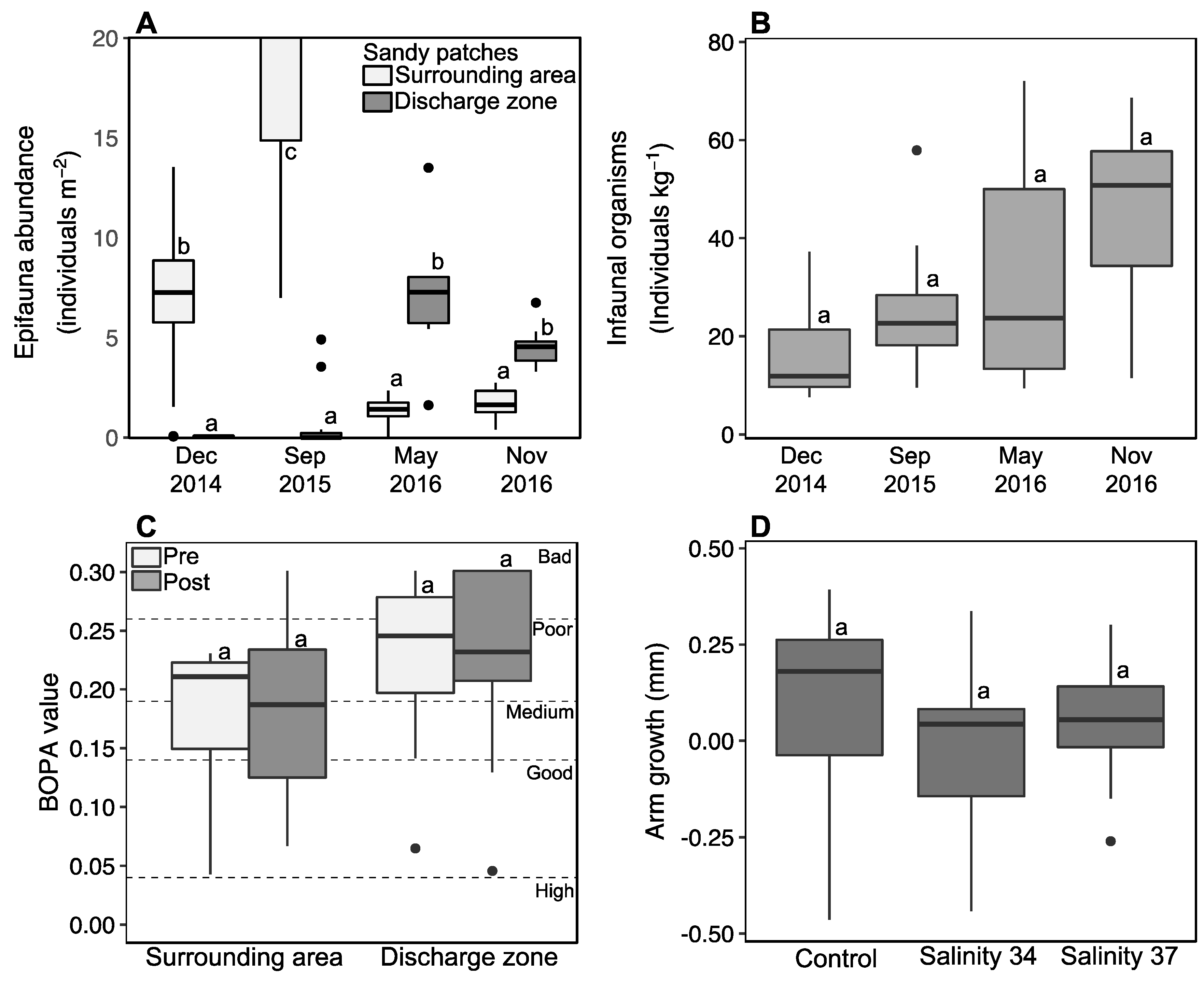Biological and Physical Effects of Brine Discharge from the Carlsbad Desalination Plant and Implications for Future Desalination Plant Constructions
Abstract
:1. Introduction
2. Methods
2.1. Study Area
2.2. Sample Collection and Biological Surveys
2.3. Water and Sediment Analyses
2.4. Bioassay Experiment
2.5. Wave Energy Model
2.6. Statistics and Geospatial Analyses
3. Results and Discussion
3.1. Physical and Chemical Characterization of the Discharge Plume
3.2. Benthic Macrofauna and Ecotoxicological Study of Brine Exposure
3.3. Future Desalination Plants in California
4. Conclusions
Supplementary Materials
Author Contributions
Funding
Acknowledgements
Conflicts of Interest
References
- Grady, C.A.; Weng, S.-C.; Blatchley, E.R. Global potable water: Current status, critical problems, and future perspectives. In Potable Water, The Handbook of Environmental Chemistry; Younos, T., Grady, C.A., Eds.; Springer International Publishing: Cham, Switzerland, 2014; pp. 37–59. [Google Scholar]
- UN-WWAP. The United Nations World Water Development Report 2015: Water for a Sustainable World; UN-WWAP: Paris, France, 2015; ISBN 978-92-3-100071-3. [Google Scholar]
- Sneed, M.; Brandt, J.; Solt, M. Land subsidence along the Delta-Mendota Canal in the northern part of the San Joaquin Valley, California, 2003–2010. Geol. Surv. Sci. Investig. Rep. 2013, 5142, 87. [Google Scholar] [CrossRef]
- Mann, M.E.; Gleick, P.H. Climate change and California drought in the 21st century. Proc. Natl. Acad. Sci. USA 2015, 112, 3858–3859. [Google Scholar] [CrossRef] [PubMed]
- AghaKouchak, A.; Cheng, L.; Mazdiyasni, O.; Farahmand, A. Global warming and changes in risk of concurrent climate extremes: Insights from the 2014 California drought. Geophys. Res. Lett. 2014, 41, 8847–8852. [Google Scholar] [CrossRef]
- Cooley, H.; Donnelly, K.; Ross, N.; Luu, P. Proposed Seawater Desalination Facilities in California, Pacific Inst. 2012. Available online: http://pacinst.org/wp-content/uploads/2013/02/full_report14.pdf (accessed on 9 November 2014).
- California American Water. Monterey Peninsula Water Supply Project. 2015. Available online: http://www.watersupplyproject.org/home (accessed on 10 October 2017).
- Pacific Institute. Existing and Proposed Seawater Desalination Plants in California. 2017. Available online: http://pacinst.org/publication/key-issues-in-seawater-desalination-proposed-facilities/ (accessed on 15 October 2017).
- Voutchkov, N. Overview of seawater concentrate disposal alternatives. Desalination 2011, 273, 205–219. [Google Scholar] [CrossRef]
- Lattemann, S.; Höpner, T. Environmental impact and impact assessment of seawater desalination. Desalination 2008, 220, 1–15. [Google Scholar] [CrossRef]
- Shenvi, S.S.; Isloor, A.M.; Ismail, A.F. A review on RO membrane technology: Developments and challenges. Desalination 2015, 368, 10–26. [Google Scholar] [CrossRef]
- Water Boards—CA EPA. California Ocean Plan; Water Boards—CA EPA: Sacramento, CA, USA, 2015. [Google Scholar]
- Jenkins, S.A. Revised Hydrodynamic Discharge Modeling Report; Poseidon Water: Carlsbad, CA, USA, 2016. [Google Scholar]
- Petersen, K.L.; Frank, H.; Paytan, A.; Bar-Zeev, E. Impacts of seawater desalination on coastal environments. In Sustainable Desalination Handbook, 1st ed.; Gude, V.G., Ed.; Butterworth-Heinemann: Oxford, UK, 2018; pp. 437–463. [Google Scholar]
- Roberts, D.A.; Johnston, E.L.; Knott, N.A. Impacts of desalination plant discharges on the marine environment: A critical review of published studies. Water Res. 2010, 44, 5117–5128. [Google Scholar] [CrossRef]
- Belkin, N.; Rahav, E.; Elifantz, H.; Kress, N.; Berman-Frank, I. The effect of coagulants and antiscalants discharged with seawater desalination brines on coastal microbial communities: A laboratory and in situ study from the southeastern Mediterranean. Water Res. 2017, 110, 321–331. [Google Scholar] [CrossRef]
- Frank, H.; Rahav, E.; Bar-Zeev, E. Short-term effects of SWRO desalination brine on benthic heterotrophic microbial communities. Desalination 2017, 417, 52–59. [Google Scholar] [CrossRef]
- Röthig, T.; Ochsenkühn, M.A.; Roik, A.; van der Merwe, R.; Voolstra, C.R. Long-term salinity tolerance is accompanied by major restructuring of the coral bacterial microbiome. Mol. Ecol. 2016, 25, 1308–1323. [Google Scholar] [CrossRef]
- Del-Pilar-Ruso, Y.; de-la-Ossa-Carretero, J.A.; Giménez-Casalduero, F.; Sánchez-Lizaso, J.L. Effects of a brine discharge over soft bottom polychaeta assemblage. Environ. Pollut. 2008, 156, 240–250. [Google Scholar] [CrossRef] [PubMed]
- Fernández-Torquemada, Y.; Sánchez-Lizaso, J.L. Effects of salinity on leaf growth and survival of the Mediterranean seagrass Posidonia oceanica (L.) Delile. J. Exp. Mar. Biol. Ecol. 2005, 320, 57–63. [Google Scholar] [CrossRef]
- Park, G.S.; Yoon, S.-M.; Park, K.-S. Impact of desalination byproducts on marine organisms: A case study at Chuja Island Desalination Plant in Korea. Desalin. Water Treat. 2011, 33, 267–272. [Google Scholar] [CrossRef]
- Sandoval-Gil, J.M.; Marín-Guirao, L.; Ruiz, J.M. The effect of salinity increase on the photosynthesis, growth and survival of the Mediterranean seagrass Cymodocea nodosa. Estuar. Coast. Shelf Sci. 2012, 115, 260–271. [Google Scholar] [CrossRef]
- Sánchez-Lizaso, J.L.; Romero, J.; Ruiz, J.; Gacia, E.; Buceta, J.L.; Invers, O.; Torquemada, Y.F.; Mas, J.; Ruiz-Mateo, A.; Manzanera, M. Salinity tolerance of the Mediterranean seagrass Posidonia oceanica: Recommendations to minimize the impact of brine discharges from desalination plants. Desalination 2008, 221, 602–607. [Google Scholar] [CrossRef]
- Lykkebo, K.; Paytan, A.; Rahav, E.; Levy, O.; Silverman, J.; Barzel, O.; Potts, D.; Bar-zeev, E. Impact of brine and antiscalants on reef-building corals in the Gulf of Aqaba e Potential effects from desalination plants. Water Res. 2018, 144, 183–191. [Google Scholar] [CrossRef]
- Yoon, S.J.; Park, G.S. Ecotoxicological effects of brine discharge on marine community by seawater desalination. Desalin. Water Treat. 2011, 33, 240–247. [Google Scholar] [CrossRef]
- Belkin, N.; Rahav, E.; Elifantz, H.; Kress, N.; Berman-Frank, I. Enhanced salinities, as a proxy of seawater desalination discharges, impact coastal microbial communities of the eastern Mediterranean Sea. Environ. Microbiol. 2015, 17, 4105–4120. [Google Scholar] [CrossRef]
- Dauvin, J.C.; Ruellet, T. Polychaete/amphipod ratio revisited. Mar. Pollut. Bull. 2007, 55, 215–224. [Google Scholar] [CrossRef]
- Riera, R.; de-la-Ossa-Carretero, J.A. Response of benthic opportunistic polychaetes and amphipods index to different perturbations in coastal oligotrophic areas (Canary archipelago, North East Atlantic Ocean). Mar. Ecol. 2014, 35, 354–366. [Google Scholar] [CrossRef]
- de-la-Ossa-Carretero, J.A.; Del-Pilar-Ruso, Y.; Giménez-Casalduero, F.; Sánchez-Lizaso, J.L. Testing BOPA index in sewage affected soft-bottom communities in the north-western Mediterranean. Mar. Pollut. Bull. 2009, 58, 332–340. [Google Scholar] [CrossRef] [PubMed]
- Joydas, T.V.; Krishnakumar, P.K.; Qurban, M.A.; Ali, S.M.; Al-suwailem, A.; Al-Abdulkader, K. Status of macrobenthic community of Manifa—Tanajib Bay System of Saudi Arabia based on a once-off sampling event. Mar. Pollut. Bull. 2011, 62, 1249–1260. [Google Scholar] [CrossRef] [PubMed]
- de-la-Ossa-Carretero, J.A.; Del-Pilar-Ruso, Y.; Loya-Fernández, A.; Ferrero-Vicente, L.M.; Marco-Méndez, C.; Martinez-Garcia, E.; Giménez-Casalduero, F.; Sánchez-Lizaso, J.L. Bioindicators as metrics for environmental monitoring of desalination plant discharges. Mar. Pollut. Bull. 2016, 103, 313–318. [Google Scholar] [CrossRef] [PubMed]
- Giangrande, A.; Licciano, M.; Musco, L. Polychaetes as environmental indicators revisited. Mar. Pollut. Bull. 2005, 50, 1153–1162. [Google Scholar] [CrossRef] [PubMed]
- Halpern, B.S.; Kappel, C.V.; Selkoe, K.A.; Micheli, F.; Ebert, C.M.; Kontgis, C.; Crain, C.M.; Martone, R.G.; Shearer, C.; Teck, S.J. Mapping cumulative human impacts to California Current marine ecosystems. Conserv. Lett. 2009, 2, 138–148. [Google Scholar] [CrossRef]
- California Department of Fish and Wildlife. California Marine Protected Areas (MPA’s). 2017. Available online: https://www.wildlife.ca.gov/Conservation/Marine/MPAs#40713287-mpas (accessed on 26 October 2017).
- Graham, M.H.; Vásquez, J.A.; Buschmann, A.H. Global ecology of the giant kelp Macrocystis: From ecotypes to ecosystems. In Oceanography and Marine Biology, 45th ed.; Gibson, R.N., Atkinson, R.J.N., Gordon, J.D.M., Eds.; Taylor and Francis Group: Boca Ranton, FL, USA, 2007; pp. 39–88. [Google Scholar]
- Phillips, B.M.; Anderson, B.S.; Siegler, K.; Voorhees, J.P.; Katz, S.; Jennings, L.; Tjeerdema, R.S. Hyper-Salinity Toxicity Thresholds for Nine California Ocean Plan Toxicity Test Protocols Preliminary Draft Final Report; California State Water Resources Control Board: Davis, CA, USA, 2012.
- Heck, N.; Paytan, A.; Potts, D.C.; Haddad, B.; Petersen, K.L. Management preferences and attitudes regarding environmental impacts from seawater desalination: Insights from a small coastal community. Ocean Coast. Manag. 2018, 163, 22–29. [Google Scholar] [CrossRef]
- Heck, N.; Petersen, K.L.; Potts, D.C.; Haddad, B.; Paytan, A. Predictors of coastal stakeholders’ knowledge about seawater desalination impacts on marine ecosystems. Sci. Total Environ. 2018, 639, 785–792. [Google Scholar] [CrossRef]
- Poseidon Water. The Carlsbad Desalination Project. 2015. Available online: http://carlsbaddesal.com (accessed on 26 October 2017).
- NOAA Satellite and Information Service, National Data Buoy Center. Hist. Data Download 2014–2017. (n.d.). Available online: http://www.ndbc.noaa.gov/download_data.php?filename=46224h2014.txt.gz&dir=data/historical/stdmet/ (accessed on 8 June 2017).
- Southern California Coastal Ocean Observation System. Bathymetry Map of Carlsbad. 2015. Available online: http://www.sccoos.org/data/bathy/?r=7 (accessed on 8 June 2015).
- Erikson, H.L.; Storlazzi, C.D.; Golden, N.E. Wave Height, Peak Period, and Orbital Velocity for the California Continental Shelf. U.S. Geology Survery Data Set. 2014. Available online: http://dx.doi.org/10.5066/F7125QNQ (accessed on 26 October 2017).
- Erikson, H.L.; Storlazzi, C.D.; Golden, N.E. Modeling Wave and Seabed Energetics on the California Continental Shelf. U.S. Geological Survey Summary of Methods to Accompany Data Release. 2014. Available online: http://dx.doi.org/10.5066/F7125QNQ (accessed on 26 October 2017).
- Murphy, J.; Riley, J.P. A modified single solution method for the determination of phosphate in natural waters. Anal. Chim. Acta 1962, 27, 31–36. [Google Scholar] [CrossRef]
- Folk, R.L. A Review of grain-size parameters. Sedimentology 1966, 6, 73–93. [Google Scholar] [CrossRef]
- Reguero, B.G.; Losada, I.J.; Méndez, F.J. A global wave power resource and its seasonal, interannual and long-term variability. Appl. Energy 2015, 148, 366–380. [Google Scholar] [CrossRef]
- Barnard, P.L.; Short, A.D.; Harley, M.D.; Splinter, K.D.; Vitousek, S.; Turner, I.L.; Allan, J.; Banno, M.; Bryan, K.R.; Doria, A.; et al. Coastal vulnerability across the Pacific dominated by El Niño/Southern Oscillation. Nat. Geosci. 2015, 8, 801. [Google Scholar] [CrossRef]
- California Department of Fish and Wildlife. Marine Region GIS Downloads. 2015. Available online: https://www.wildlife.ca.gov/Conservation/Marine/GIS/Downloads (accessed on 26 October 2017).
- Jacox, M.G.; Hazen, E.L.; Zaba, K.D.; Rudnick, D.L.; Edwards, C.A.; Moore, A.M.; Bograd, S.J. Impacts of the 2015–2016 El Niño on the California Current System: Early assessment and comparison to past events. Geophys. Res. Lett. 2016, 43, 7072–7080. [Google Scholar] [CrossRef]
- Ahmad, N.; Baddour, R.E. A review of sources, effects, disposal methods, and regulations of brine into marine environments. Ocean Coast. Manag. 2014, 87, 1–7. [Google Scholar] [CrossRef]
- Del-Pilar-Ruso, Y.; Martinez-Garcia, E.; Giménez-Casalduero, F.; Loya-Fernández, A.; Ferrero-Vicente, L.M.; Marco-Méndez, C.; de-la-Ossa-Carretero, J.A.; Sánchez-Lizaso, J.L. Benthic community recovery from brine impact after the implementation of mitigation measures. Water Res. 2015, 70, 325–336. [Google Scholar] [CrossRef] [PubMed]
- Iso, S.; Suizu, S.; Maejima, A. The lethal effect of hypertonic solutions and avoidance of marine organisms in relation to discharged brine from a destination plant. Desalination 1994, 97, 389–399. [Google Scholar] [CrossRef]
- Stöhr, S.; O’Hara, T.D.; Thuy, B. Global diversity of brittle stars (Echinodermata: Ophiuroidea). PLoS ONE 2012, 7, e00319040. [Google Scholar] [CrossRef]
- Blicher, M.; Sejr, M. Abundance, oxygen consumption and carbon demand of brittle stars in Young Sound and the NE Greenland shelf. Mar. Ecol. Prog. Ser. 2011, 422, 139–144. [Google Scholar] [CrossRef]
- Vopel, K.; Thistle, D.; Rosenberg, R. Effect of the brittle star Amphiura filiformis (Amphiuridae, Echinodermata) on oxygen flux into the sediment. Limnol. Oceanogr. 2003, 48, 2034–2045. [Google Scholar] [CrossRef]
- de-la-Ossa-Carretero, J.A.; Del-Pilar-Ruso, Y.; Loya-Fernández, A.; Ferrero-Vicente, L.M.; Marco-Méndez, C.; Martinez-Garcia, E.; Sánchez-Lizaso, J.L. Response of amphipod assemblages to desalination brine discharge: Impact and recovery. Estuar. Coast. Shelf Sci. 2016, 172, 13–23. [Google Scholar] [CrossRef]
- Young, M.A.; Cavanaugh, K.C.; Bell, T.W.; Raimondi, P.T.; Edwards, C.A.; Drake, P.T.; Erikson, L.; Storlazzi, C. Environmental controls on spatial patterns in the long-term persistence of giant kelp in central California. Ecology 2015, 86, 45–60. [Google Scholar] [CrossRef]
- Hamilton, S.L.; Caselle, J.E. Exploitation and recovery of a sea urchin predator has implications for the resilience of southern California kelp forests. Proc. Biol. Sci. 2015, 282, 20141817. [Google Scholar] [CrossRef] [PubMed]
- Gacia, E.; Invers, O.; Manzanera, M.; Ballesteros, E.; Romero, J. Impact of the brine from a desalination plant on a shallow seagrass (Posidonia oceanica) meadow. Estuar. Coast. Shelf Sci. 2007, 72, 579–590. [Google Scholar] [CrossRef]
- Missimer, T.M.; Maliva, R.G. Environmental issues in seawater reverse osmosis desalination: Intakes and outfalls. Desalination 2017, 434, 198–215. [Google Scholar] [CrossRef]
- Fernández-Torquemada, Y.; Ferrero-vicente, L.; Gónzalez-correa, J.M.; Loya, A.; Ferrero, L.M.; Díaz-valdés, M.; Sánchez-lizaso, J.L. Dispersion of brine discharge from seawater reverse osmosis desalination plants. Desalin. Water Treat. 2009, 5, 137–145. [Google Scholar] [CrossRef]







| Sampling Time | Distance from Outfall Mouth (m) | Water Level | Salinity | Temperature | ||||
|---|---|---|---|---|---|---|---|---|
| Mean | Max | Min | Mean | Max | Min | |||
| December 2014 | 50–200 (Immediate) | Surface (n = 5) | 33.6 b (0.06) | 33.6 | 33.5 | 18.4 b (0.7) | 19.0 | 17.4 |
| Bottom (n = 4) | 33.5 BC (0.01) | 33.6 | 33.5 | 18.2 B (0.8) | 19.3 | 17.1 | ||
| 250–1000 (Surrounding) | Surface (n = 5) | 33.4 b (0.1) | 33.5 | 33.3 | 18.8 b (0.6) | 19.5 | 18.4 | |
| Bottom (n = 4) | 33.5 BC (0.1) | 33.7 | 33.4 | 19.1 B (0.3) | 19.4 | 18.8 | ||
| September 2015 | 50–200 (Immediate) | Surface (n = 8) | 33.1 b (0.7) | 33.5 | 31.5 | 24.9 a (0.7) | 26.5 | 24.0 |
| Bottom (n = 6) | 33.5 C (0.2) | 33.9 | 33.0 | 24.5 A (0.3) | 25.2 | 24.1 | ||
| 250–1000 (Surrounding) | Surface (n = 8) | 33.4 b (0.07) | 33.5 | 30.4 | 24.3 a (0.5) | 25.2 | 23.7 | |
| Bottom (n = 6) | 32.8 C (1.2) | 33.5 | 33.3 | 24.4 A (0.5) | 25.1 | 23.9 | ||
| May 2016 | Mouth of outfall | Surface | 37.4 a | 37.4 | 37.4 | NA | NA | NA |
| 50–200 (Immediate) | Surface (n = 7) | 33.9 b (0.7) | 35.5 | 33.6 | 19.1 b (0.4) | 19.4 | 18.2 | |
| Bottom (n = 6) | 34.9 A (0.7) | 35.7 | 33.9 | 19.3 B (0.8) | 19.8 | 17.8 | ||
| 250–1000 (Surrounding) | Surface (n = 7) | 33.4 b (0.5) | 33.8 | 32.5 | 18.8 b (0.6) | 19.4 | 17.9 | |
| Bottom (n = 7) | 34.4 AB (0.7) | 35.2 | 33.5 | 17.9 B (1.4) | 19.4 | 15.5 | ||
| November 2016 | 50–200 (Immediate) | Surface (n = 7) | 33.5 b (0.2) | 33.9 | 33.4 | 19.1 b (0.3) | 19.7 | 18.8 |
| Bottom (n = 6) | 34.4 AB (0.2) | 35.9 | 34.8 | 19.3 B (0.5) | 20.0 | 18.6 | ||
| 250–1000 (Surrounding) | Surface (n = 7) | 33.5 b (0.2) | 33.9 | 33.3 | 19.1 b (0.6) | 19.9 | 18.0 | |
| Bottom (n = 7) | 34.4 A (0.8) | 35.9 | 33.6 | 18.7 B (0.7) | 19.5 | 17.3 | ||
© 2019 by the authors. Licensee MDPI, Basel, Switzerland. This article is an open access article distributed under the terms and conditions of the Creative Commons Attribution (CC BY) license (http://creativecommons.org/licenses/by/4.0/).
Share and Cite
Lykkebo Petersen, K.; Heck, N.; G. Reguero, B.; Potts, D.; Hovagimian, A.; Paytan, A. Biological and Physical Effects of Brine Discharge from the Carlsbad Desalination Plant and Implications for Future Desalination Plant Constructions. Water 2019, 11, 208. https://doi.org/10.3390/w11020208
Lykkebo Petersen K, Heck N, G. Reguero B, Potts D, Hovagimian A, Paytan A. Biological and Physical Effects of Brine Discharge from the Carlsbad Desalination Plant and Implications for Future Desalination Plant Constructions. Water. 2019; 11(2):208. https://doi.org/10.3390/w11020208
Chicago/Turabian StyleLykkebo Petersen, Karen, Nadine Heck, Borja G. Reguero, Donald Potts, Armen Hovagimian, and Adina Paytan. 2019. "Biological and Physical Effects of Brine Discharge from the Carlsbad Desalination Plant and Implications for Future Desalination Plant Constructions" Water 11, no. 2: 208. https://doi.org/10.3390/w11020208
APA StyleLykkebo Petersen, K., Heck, N., G. Reguero, B., Potts, D., Hovagimian, A., & Paytan, A. (2019). Biological and Physical Effects of Brine Discharge from the Carlsbad Desalination Plant and Implications for Future Desalination Plant Constructions. Water, 11(2), 208. https://doi.org/10.3390/w11020208





